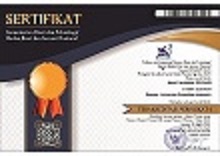The Implementation Of Solar Refelective Technology To Reduce House Temperature And Urban Heat Island Impact: A Case Study In Pangandaran Indonesia
Abstract
Full Text:
PDFReferences
Afonso, A., Ramírez, J. J., & Díaz-Puente, J. M. (2012). University-industry cooperation in the education domain to foster competitiveness and employment. Procedia-Social and Behavioral Sciences, 46, 3947–3953.
ARIEF SABARUDDIN. (n.d.).
Ashrafuzzaman, M., & Rahman, Md. S. (2020). Discussion on Biotechnology and Food Policy Taking China’s Genetically Modified Organisms (GMOs). Asian Research Journal of Arts & Social Sciences, 12, 14–22. https://doi.org/10.9734/ARJASS/2020/v12i430195
Bajare, D., Puzule, L., Sinka, M., Tambovceva, T., & Bumanis, G. (2024). Life Cycle Assessment of the Lightweight Timber Structures with Bio-Based Aggregate Composites. International Conference" Coordinating Engineering for Sustainability and Resilience", 582–591.
Churkina, G. (2016). The role of urbanization in the global carbon cycle. Frontiers in Ecology and Evolution, 3, 144.
Etxebarria, M., Oregi, X., Grijalba, O., & Hernández, R. J. (2020). Relationship between energy demand, indoor thermal behaviour and temperature-related health risk concerning passive energy refurbishment interventions. Rigas Tehniskas Universitates Zinatniskie Raksti, 24(2), 348–363.
Halenka, T., Langendijk, G., & Hoffmann, P. (2024). CORDEX Flagship Pilot Study URB-RCC: Urban Environments and Regional Climate Change. Copernicus Meetings.
Harwianti, R. (2022). SISTEM PENDUKUNG KEPUTUSAN BANTUAN PENINGKATAN RUMAH MENGGUNAKAN METODE VIKOR PADA KANTOR DESA PANCA KARSA I. Jurnal Sistem Informasi SIBerPro, 7(2), 37–47.
Herr, C. M. (2015). Action research as a research method in architecture and design. Proceedings of the 59th Annual Meeting of the ISSS-2015 Berlin, Germany, 1(1).
Hoe, K. C., & Wahab, H. A. (2013). Sokongan politik dan penglibatan masyarakat dalam program pembasmian kemiskinan di Sarawak. Malaysia Journal of Society and Space, 9, 89–97.
Hong, C., Wang, Y., Gu, Z., & Yu, C. W. (2022). Cool facades to mitigate urban heat island effects. In Indoor and Built Environment (Vol. 31, Issue 10, pp. 2373–2377). SAGE Publications Sage UK: London, England.
Huang, B., Xing, K., & Rameezdeen, R. (2023). Exploring embodied carbon comparison in lightweight building structure frames: A case study. Sustainability, 15(20), 15167.
Jhariya, M. K., Raj, A., Banerjee, A., Meena, R. S., Devi, A., & Kittur, B. H. (2024). Urban emission reduction and carbon management. In Agroforestry for Carbon and Ecosystem Management (pp. 161–171). Elsevier.
Kaya, D., Çanka Kılıç, F., & Öztürk, H. H. (2021). Energy Saving with Heat Insulation. In Energy Management and Energy Efficiency in Industry: Practical Examples (pp. 443–462). Springer.
Khorat, S., Das, D., Khatun, R., Aziz, S. M., Anand, P., Khan, A., Santamouris, M., & Niyogi, D. (2024). Cool roof strategies for urban thermal resilience to extreme heatwaves in tropical cities. Energy and Buildings, 302, 113751.
Khosravi, H., Sahebi, H., & Ahmed, I. (2023). Building Energy Efficiency through Advanced Regression Models and Metaheuristic Techniques for Sustainable Management. ArXiv Preprint ArXiv:2305.08886.
Kullberg, A. T., & Feeley, K. J. (2023). Urban heat islands and what they can teach us about climate change. Frontiers for Young Minds, 11, 943515.
Lapisa, R., Karudin, A., Martias, M., Krismadinata, K., Ambiyar, A., Romani, Z., & Salagnac, P. (2020). Effect of skylight–roof ratio on warehouse building energy balance and thermal–visual comfort in hot-humid climate area. Asian Journal of Civil Engineering, 21, 915–923.
Leal Filho, W., Tuladhar, L., Li, C., Balogun, A.-L. B., Kovaleva, M., Abubakar, I. R., Azadi, H., & Donkor, F. K. K. (2022). Climate change and extremes: implications on city livability and associated health risks across the globe. International Journal of Climate Change Strategies and Management, 15(1), 1–19.
Macintyre, H. L., & Heaviside, C. (2019). Potential benefits of cool roofs in reducing heat-related mortality during heatwaves in a European city. Environment International, 127, 430–441.
Mbise, F. P., & Sosiya, T. (2023). Impact of outreach programmes on the relationship between local people and parks. Perceptions of communities near Tarangire National Park, Tanzania. Global Ecology and Conservation, 42, e02411.
Nandi, N., & Dede, M. (2022). Urban heat island assessment using remote sensing data in West Java, Indonesia: From literature review to experiments and analyses. Indonesian Journal of Science and Technology, 7(1), 105–116.
Omonijo, A. G. (2017). Assessing seasonal variations in urban thermal comfort and potential health risks using Physiologically Equivalent Temperature: A case of Ibadan, Nigeria. Urban Climate, 21, 87–105.
Paramita, B., Kusuma, H. E., & Matzarakis, A. (2022). Urban performance based on biometeorology index in high-density, hot, and humid cities. Sustainable Cities and Society, 80, 103767.
Pontius, J., & McIntosh, A. (2024). Urban Heat Islands. In Environmental Problem Solving in an Age of Climate Change: Volume One: Basic Tools and Techniques (pp. 119–133). Springer.
Ramadhan, T., Paramita, B., & Srinivasan, R. S. (2022). Study of Cost and Construction Speed of Cladding Wall for Lightweight Steel Frame (LSF). Buildings, 12(11), 1958.
Razak, K. A., Ramlee, L. H. S., Sapiee, H. Y., Siow, Y. M., Muda, R. S., Bakar, R. A., Mohamed, Z., Ramli, Z., & Lee, C. S. N. K. P. (2024). Advancing Local Disaster Resilience Strategies: A Transdisciplinary Approach. Copernicus Meetings.
Rosenbaum, W. A. (2024). Methane Reduction. In Elgar Encyclopedia of Climate Policy (pp. 343–346). Edward Elgar Publishing.
Soesilowati, E. (2017). Model for empowering farmers at dry land through quadruple helix approach. Journal of Arts and Humanities, 6(4), 1–9.
Szemerédi, E., & Remsei, S. (2024). Disproportionate exposure to urban heat island intensity–The case study of Győr, Hungary. Hungarian Geographical Bulletin, 73(1), 17–33.
Tewari, K., Tewari, M., & Niyogi, D. (2023). Need for considering urban climate change factors on stroke, neurodegenerative diseases, and mood disorders studies. Computational Urban Science, 3(1), 4.
Thün, G., & Velikov, K. (2011). Action research and prototype testbeds: prioritizing collaborative making in architectural research. Proceedings of ARCC 2011: Considering Research: Reflecting upon Current Themes in Architecture Research, 315–325.
Wang, J., Jiang, C., Yang, G., Bai, G., & Yu, S. (2023). Study on thermal health and its safety management mode for the working environment. Frontiers in Public Health, 11, 1227630.
DOI: https://doi.org/10.17509/jaz.v8i2.81726
Refbacks
- There are currently no refbacks.
Copyright (c) 2025 Ana Ramdani Sari

This work is licensed under a Creative Commons Attribution-ShareAlike 4.0 International License.





